Kumta 3: Field of Dreams

Road leading from my cousin's house to the Kumta market. It's a 10 minute walk. Bicycles are family vehicles here. Mom and infant are calmly enjoying the ride on the rack.
Note: open drains to carry heavy rain water run-off; cows resting ahead on road side.
And across is this spectacular rice field. Despite having seen this field
hazaar times, I am ever in awe. Depending on the time of day, or year, its a different scene. These pics are from an evening in September 2004; the light has a golden tinge and shadows are getting long. Monsoon rains have just ended, and the crop is starting to mature.
In this God-fearing country, the parting greeting is:
Dev Bare Karo! literally,
May God do you good!
Kumta 2: Main Street
The
Vegetable market sits on one end of Main Street Kumta. Always a treat to walk the remaining few blocks and watch people. The stores are tiny and carry whatever you would need. Nothing fancy here, just life's essentials. Several temples are on this street, and thus flower sellers everywhere.
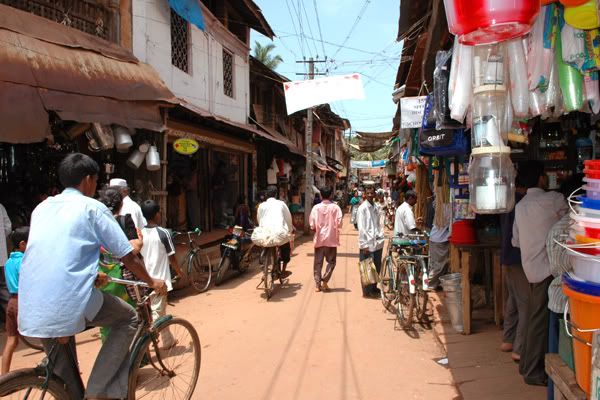
Notice the reddish tinged road. That comes from the reddish-brown Laterite rock this entire Konkan region sits atop. In the konkan, everything is made from laterite: buildings, fence walls, bus-stop shelters, stores and even gutters draining road sides. Crushed laterite gravel is used on the shoulders of all roads. Even the dust has a reddish tinge, and so does the normally black asphalt road. After a few days in the konkan, my sense of white clothes now account for a trace of red in it :-)
Let's take a stroll down Main Street!The Venkateshwara Devasthan is in the center of town. I love exploring the inside of this very old, beautiful temple. Piles of sand and gravel outside point to imminent construction - pray nothing gaudy!
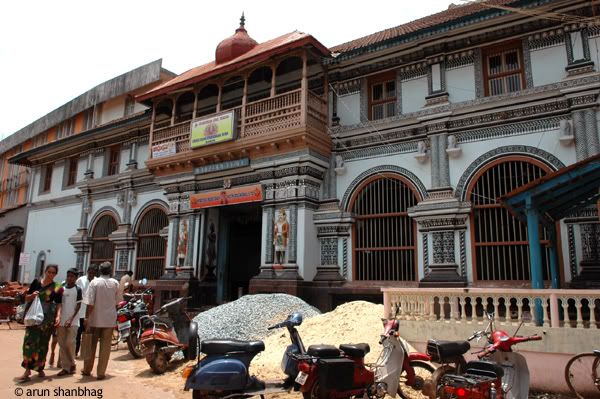
Nearby is the Shanteri-Kamakshi Temple. A thread-ceremony was going on inside and these girls, dressed in new clothes, were welcoming guests. Women received flower strands for their hair, men (and women) got sprinkled with perfumed water. Note the girl in red reaching for the small chrome sprinkler.
After walking in the hot sun, my cousin and I decided to gate-crash this ceremony for some cool lemonade and
mithai. We smiled at the girls, got doused in perfumed water and smiled our way to the back of the temple where the lemonade was still being mixed. There as we waited, the assistant picked up a block of ice sitting on the bare floor and tossed it in the giant pot (aaarrrghhhh!) !! I had no intention of getting an upset stomach at the start of my holidays. Mithai too was nowhere to be seen :-( We walked out dejected. O yes, I did bow my head at the shrine.
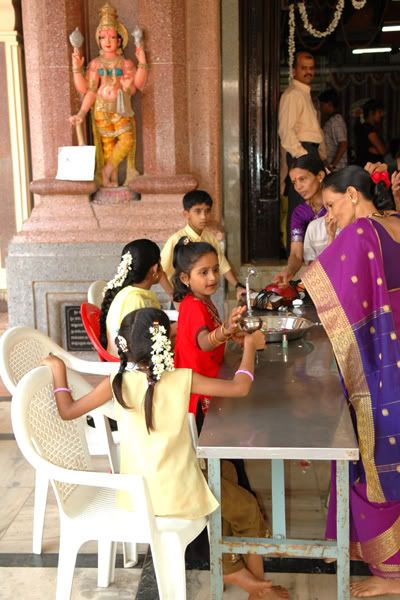
Right outside the temple I tried taking a pic of the squatting flower-seller, and this women walked right into my field. Her expression suggests she was carrying a huge burden on her already drooping shoulders.
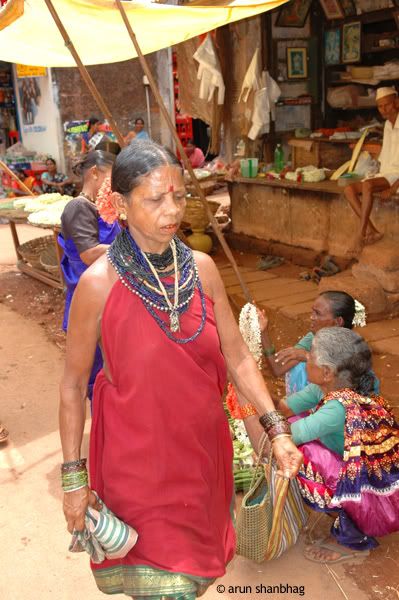
Parched throats made us dash to the corner shop with the red and white awning (Nayak's Cold drinks?). Note the women selling an assortment of flowers, vegetables or fruits. Generally whatever grows on their plot.
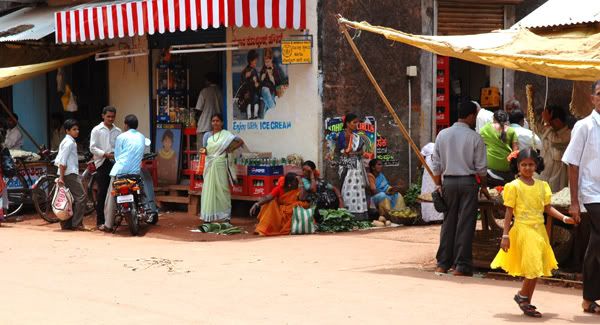
On the back table as we waited to order Nimbu-soda, a local person still sitting there was sipping, what looked like a glass of cold-coffee.
Raagi Neeru (
Nanchane water) he noted. I remembered my grandmother making Raagi Neeru for us kids playing in the hot summer sun. Then we find, the owner's wife makes it at home. So it was a no-brainer - Delicious too! They also served
Teela Udak (white sesame water). Had to try that as well. After a few glasses of each, we were well prepared to brave the midday sun. Note empty glasses on table! :-)
Apparently a very simple recipe for these cool-drinks. Roasted
Nanchane or white sesame seeds are ground with some coconut gratings,
gur and water. Thats it! Ayurveda experts would swear at how it would 'cool' the body from the inside! Amen!
Note: See also Indu's
recipe for Ragi Ladoo.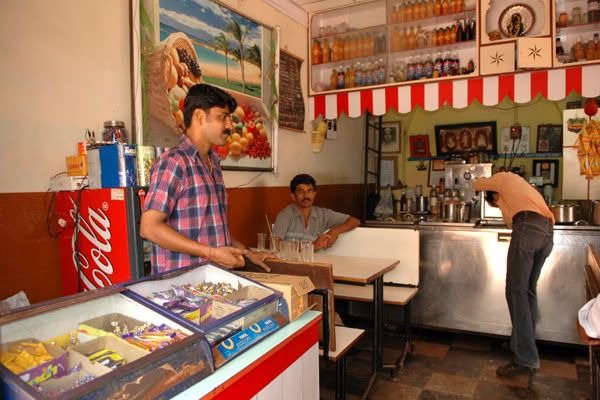
Namaskar!
Kumta 1: Jewel of the Konkan
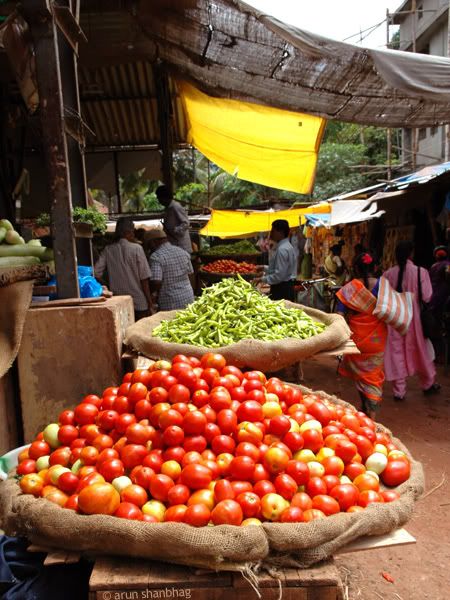
Every visit to India, I follow a travel ritual. We head to Goa to pay our respects at the
Ramnathi Devasthan in Ponda. From there we head south along the coast to Kumta.
Kumta is a sleepy township. The busiest part of town is Main Street, called
paent, which is only a few blocks long. The place for any and all your shopping. Its where all the locals 'hang-out' too. There is not much else to do in Kumta. Rest and relax.
And best of all - I get to speak konkani all over town! My konkani is good enough, I easily pass off as "from Mumbai" (which is not incorrect)! Yes, every shop-owner, rickshaw driver, stall-wallah, lady selling vegetables, and their brother speaks Konkani. :-) So even among strangers, I feel at home.
In the mornings, the local market is buzzing. It's only a few rows of vegetables and fruits. And not surprisingly, friendly folks and juicy vegetable and fruits everywhere.
Join me for a short tour of the Kumta Vegetable Market!This pair of smiley guys seemed to have the biggest stall there.
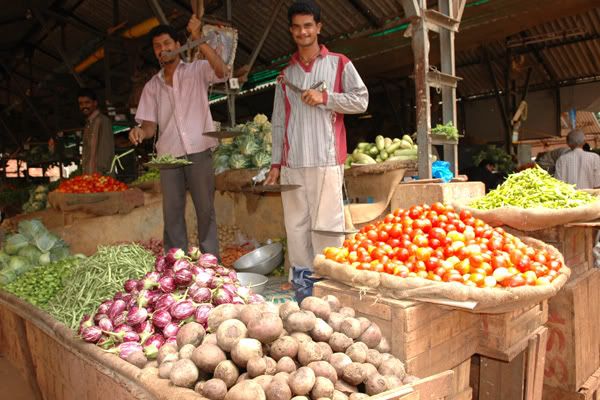
These brinjals (?) were mouth watering. Appears to be a hybrid between a "Gullaen" and the brinjal. Can someone shed more light on this?
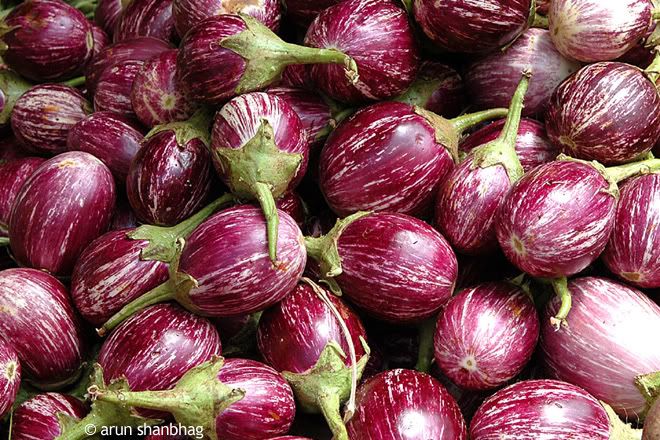
Yes! MANGOES! BTW, this was from our May-June trip. Those little green ones are deceptively sweet. Called
manik-bhat, a local variety and very popular all over the konkan coast.
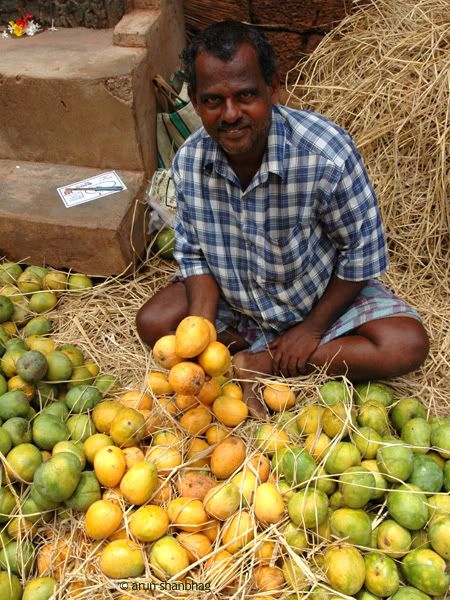 Who said, sucking up cannot be sweet!
Who said, sucking up cannot be sweet!Thats the way to eat the
manik-bhat mangoes. Wash (optional), pinch the stem and make a small hole. Gently roll and squeeze the mango, so the pulp is ejected into your mouth. Suck, fast. Discard the leftover at a nearby cow who will glady finish it off :-)
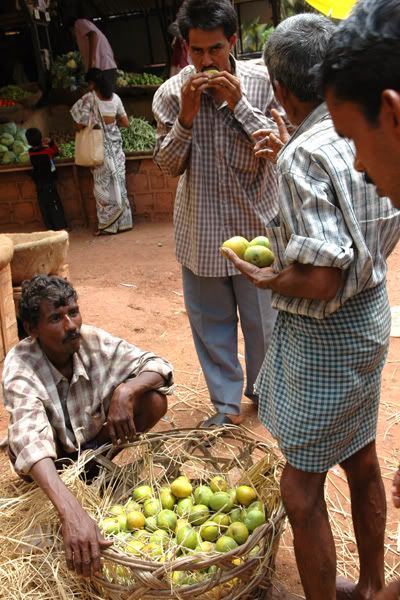
As I negotiated my way around the market shooting pics and striking conversation with the shop-keepers, this girl selling a grab-bag of spices and colors was giggling. Not sure what she found humorous. When I turned my camera on her, ... she was full of modesty.
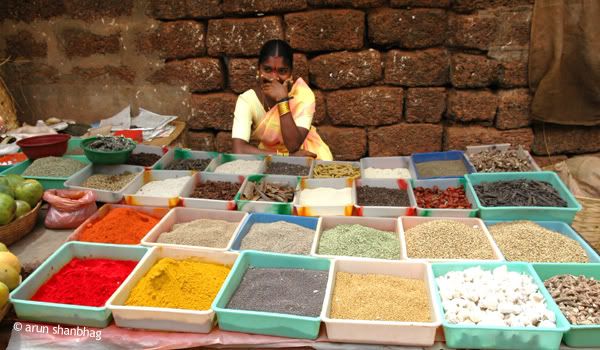
Here is a tighter crop, lightening her endearingly beautiful features.
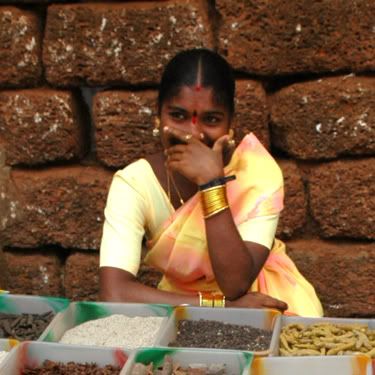
For every guy who ever wondered:
What women really want?The largest crowd was in front of this stall which sold bangles, earrings, nose-rings, bracelets, anklets and other trinkets. Note the women who have orange flowers in their hair (3rd from left; 2nd and 4th from right). Those are the traditional
aboli flower strands, very common in the konkan. (see next pic).
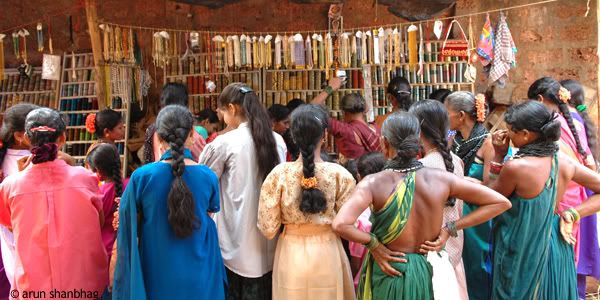
On the market, a woman was selling these (l to r) drumsticks topped with woven
aboli flower strands; dainty lady-fingers (a longer and delicate version of the Okra available in the US); a ripe pineapple; more drumsticks (these appear less fleshy) and a bowl with more flower stringers.
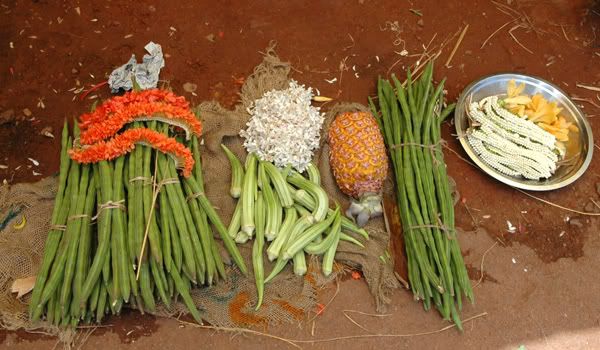
My question is this: Even if the women selling flowers, spices, and the small guys selling mangoes, were to sell all their produce by the end of the day (highly unlikely), how much money would they earn? Would it be enough to buy other food for their familiy, clothes, school tuition? savings perhaps? Something to think about!
My visits to Kumta are times for introspection. While M stays at home and rests and lazes around, I walk the markets, the alleys, the temples, and talk, talk and talk. With the guy selling mangoes, the vegetable seller, the woman here, the flower seller there, the shopkeeper elsewhere. I want to know them, see the world from their eyes. With all my education and training, what can I do for them? What can you do for them?








 Every visit to India, I follow a travel ritual. We head to Goa to pay our respects at the
Every visit to India, I follow a travel ritual. We head to Goa to pay our respects at the 







